MSI appears to sniff that we love SFF stuff so they decided to send the Z590I Unify for a much needed review. This is a high-end Mini-ITX motherboard featuring Thunderbolt connectors and a chunky set of aluminum heatsinks. This board also supports DSD playback via the ALC1220P codec. Interesting!
Aside from those defining features, the motherboard also sports a 2.5GbE LAN, Wi-Fi 6E and the usual stuff that came with the Intel Z590 chipset.
Disclosure: MSI sent this motherboard together with a retail sample of the Intel Core i9-11900K for the purpose of this review. The company did not pay me to say anything particular about both. That said, all thoughts and opinions are of my own.
- Product link: MSI MEG Z590I UNIFY Gaming Motherboard Mini-ITX
- Availability: Released, Worldwide
- Price: ₱20,230, Retail / $369.99, Amazon
Table of Contents:
- 1 Technical Specifications
- 2 Packaging and Accessories
- 3 Design, Build and Connectivity
- 4 Firmware Interface
- 5 Test Setup and Methodology
- 6 Temperature
- 7 Power Consumption
- 8 Noise Level
- 9 CPU, Memory and GPU:
- 10 Storage Interface
- 11 Audio Interface
- 12 Network Interface
- 13 Software, Lighting and Special Features
- 14 Final Thoughts
Technical Specifications
| Processor | |
| CPU Support | Intel 11th/10th Gen Core, Pentium Gold, Celeron Processors |
| Chipset | Intel Z590 |
| Socket | Intel Socket LGA1200 |
| Memory | |
| SDRAM | DDR4 Non-ECC, ECC in Non-ECC Mode |
| Slot | 2x DIMM |
| Channel | Dual Channel |
| Frequency | 5600MHz (Max) |
| Capacity | 64GB (Max) |
| Graphics | |
| GPU | DisplayPort 1.4, HDMI 2.0, 2x MiniDP |
| Multi-GPU | — |
| Expansion | |
| PCI Express | PCIe 4.0 x16 |
| Bifurcation | — |
| Storage | |
| SATA | SATA III |
| M.2 | SATA III, NVMe |
| RAID | RAID 0, 1, 5, 10 |
| Network | |
| LAN | Intel I225-V 2.5Gbps |
| WLAN | Intel Wi-Fi 6E AX210 |
| Bluetooth | Version 5.2 |
| Audio | |
| DAC | Realtek ALC1220P |
| ADC | Realtek ALC1220P |
| Amplifier | Embedded |
| Channel | 7.1 |
| Rear IO | |
| USB | 2x 3.2 Gen 2, 2x 3.2 Gen 1, 2x Legacy |
| eSATA | — |
| Thunderbolt | 2x Type-C, 2x MiniDP |
| LAN | RJ-45 |
| Audio | 3x 3.5mm |
| Display | DisplayPort 1.4, HDMI 2.0, 2x MiniDP |
| Front IO / Internal | |
| USB | USB 3.2 Gen 2, USB 3.2 Gen 1 |
| SATA | 4x SATA |
| M.2 | 2x M.2 |
| Audio | AAFP |
| Fan | 3x 4-Pin |
| LED | 3-Pin |
| Dimensions | |
| Length | 170mm |
| Width | 170mm |
| Height | 45mm |
| Weight | — |
Packaging and Accessories
MSI had the Z590I Unify packed in their usual double compartment motherboard packaging.
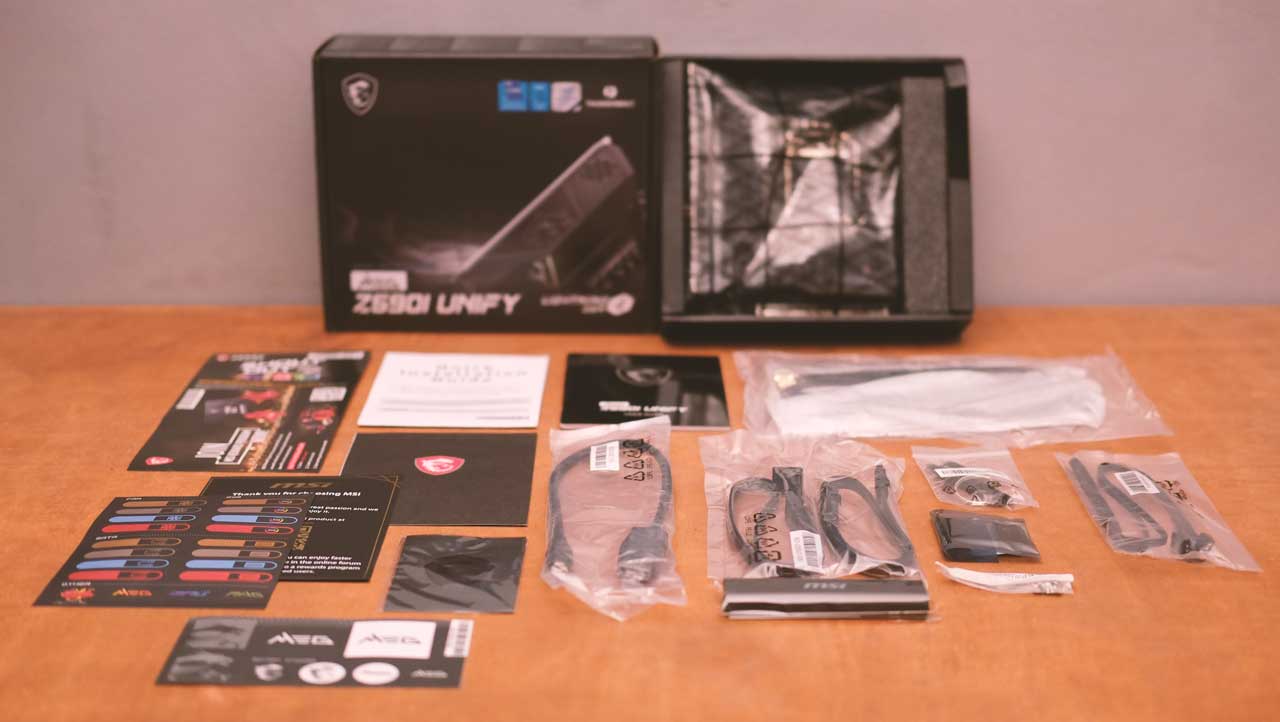
The product comes with the following items inside:
- Main Unit
- Wi-Fi Antenna
- User Manual
- Quick Installation Guide
- USB Thumb Drive
- MEG Stickers
- Reward Program / Flyers
- Cable Stickers
- Product Catalogue
- Registration Card
- Cleaning Brush
- 2x Screw Drivers
- Case Badge
- 2x SATA Cables
- ARGB LED Cable
- DP to MiniDP Cable
- 2x M.2 Screw Set
Pretty awesome bundles we got here. Appropriate for a high-end motherboard model.
Design, Build and Connectivity
MSI went all black with an egde for the MEG Z590I Unify’s colorway. This is a beefy Mini-ITX motherboard with thick aluminum heatsinks and rear IO top cover. Yes, the rear IO’s top cover is actually made out of aluminum and is a part of the cooling solution.
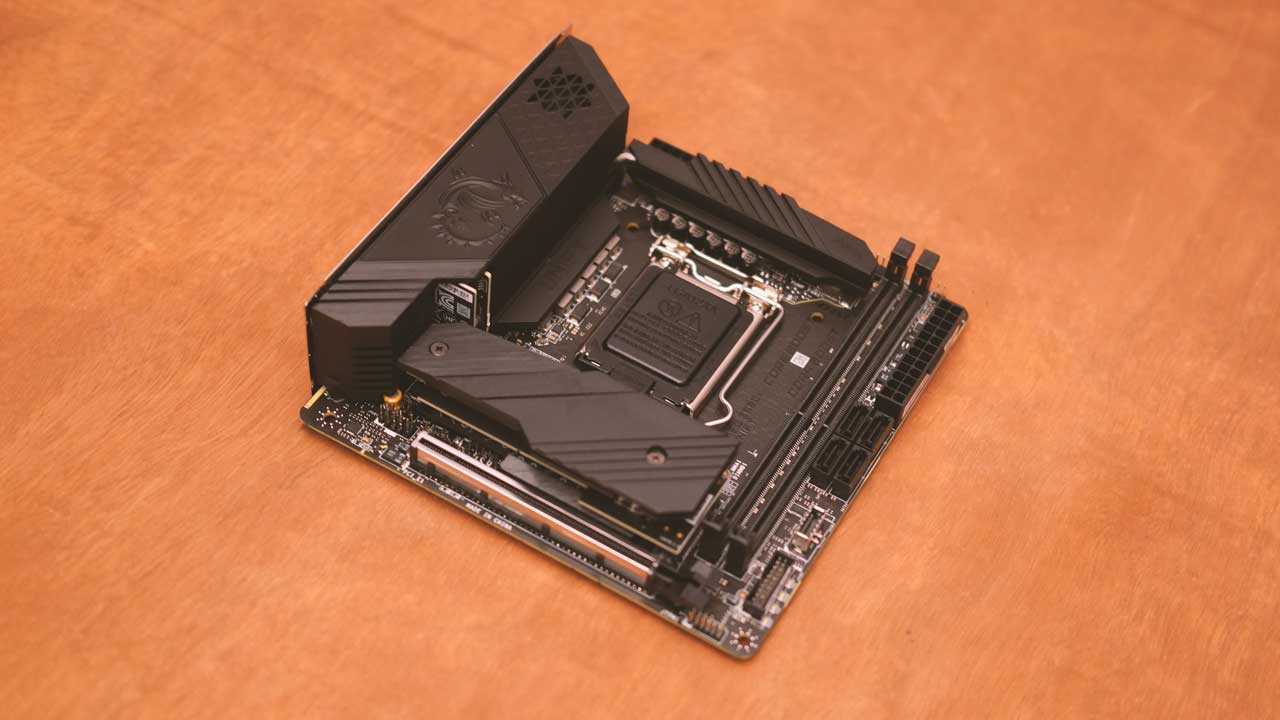
Back area shows more about the soldering job involved into making the board. It’s nice to see a passively cooled VRM area here along with the PCB separation for the audio components.
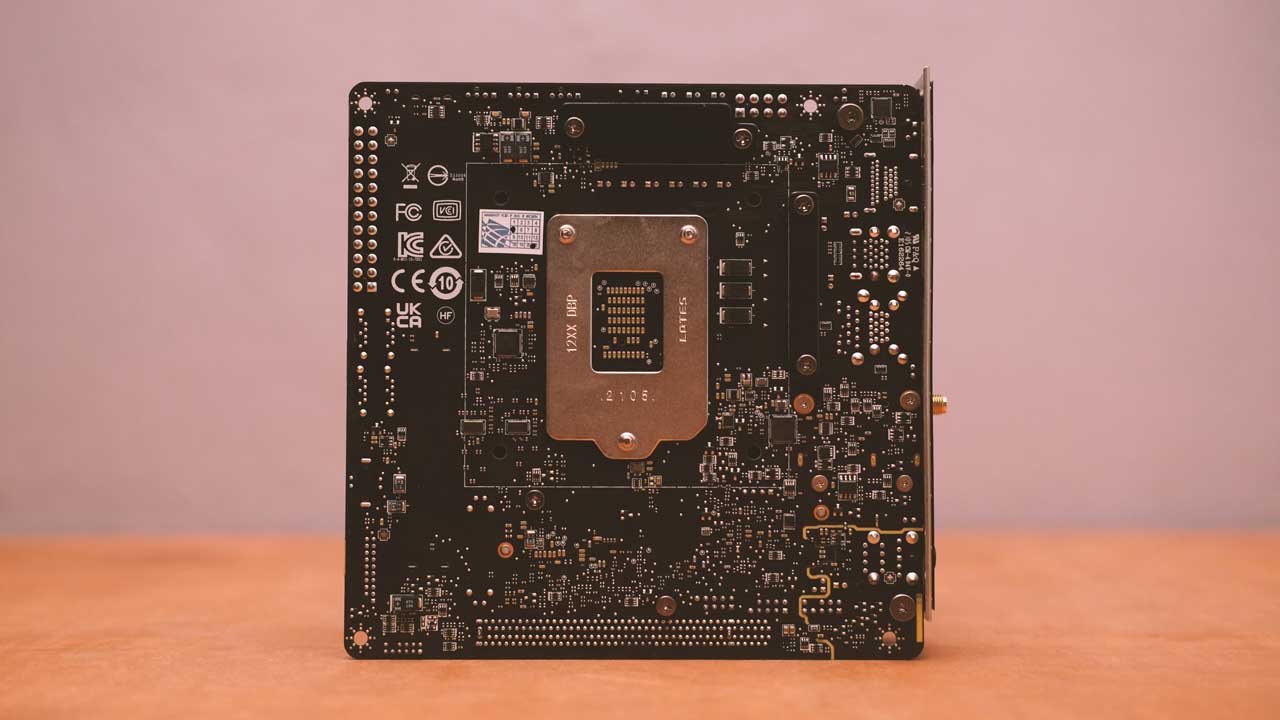
Powering the CPU is a direct 8 phase digital power design featuring INTERSIL’s digital PWM controller and 90A power stages. We also got the 4-pin fan headers here all of course capable of PWM and DC mode.
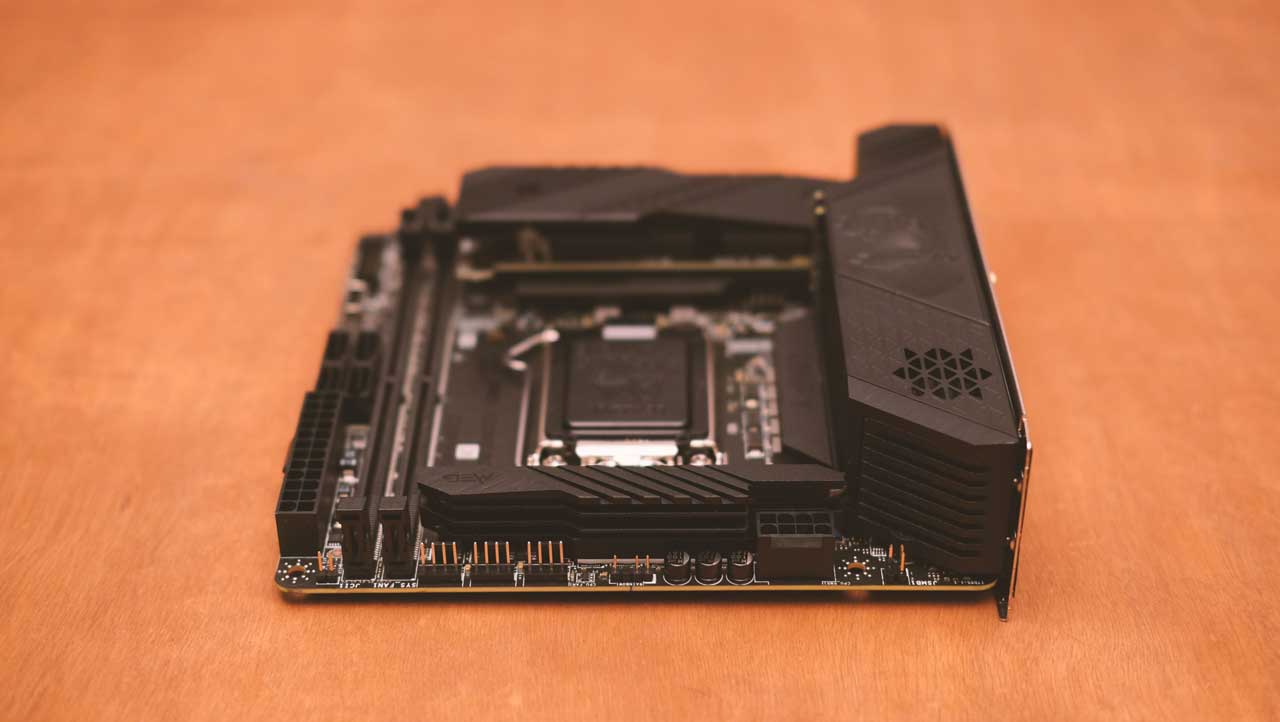
We have the usual suspects here as far as storage headers are concerned. I want to see the TPM header here though as opposed to its actual position under the PCIe slot’s latch.
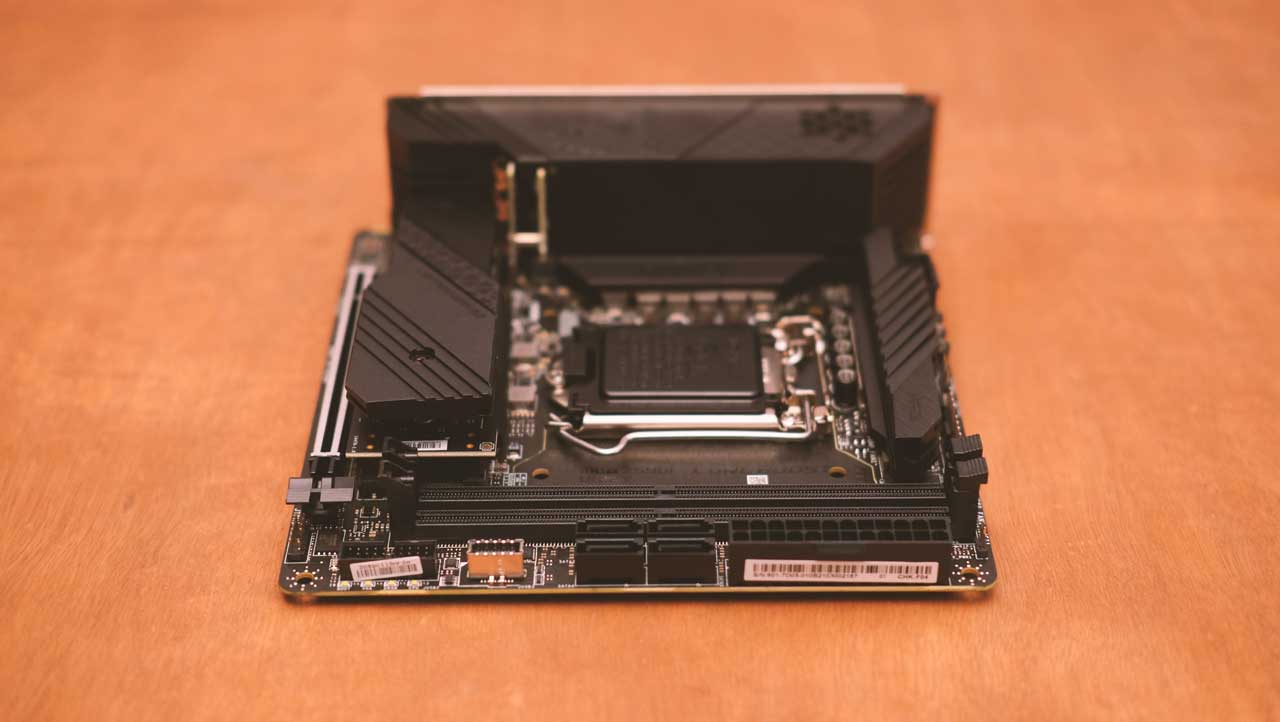
Bottom row is busy as usual. We have a double decker style M.2 slot design here so cooling for both is shared along with the chipset’s. That’s something you have to think about if you’re going to populate the slots with ultra-fast SSDs.
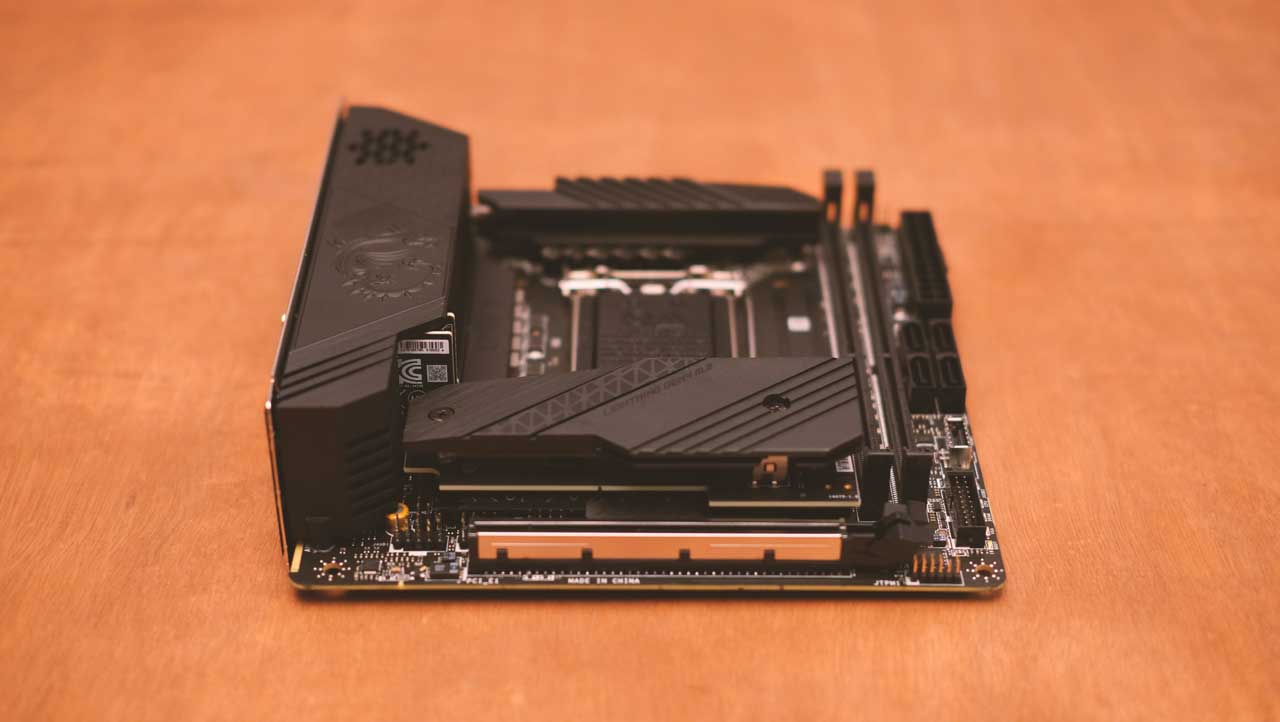
Rear I/O ports are excellent. We actually have four display outputs here, quad Thunderbolt ports and a clear CMOS button. You’d also find perforations here for the onboard 40mm fan.
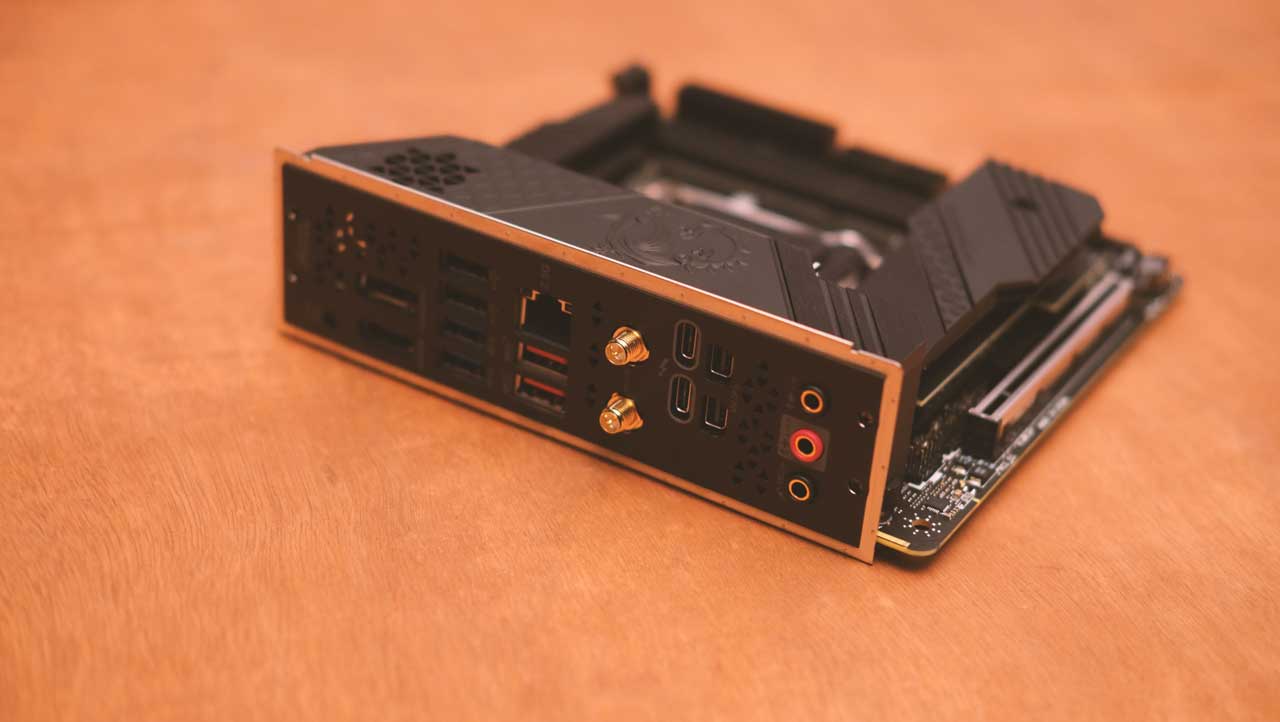
Excellent board design and quality wise with the exception of the sandwich style M.2 slot design, and the TPM header at the wrong place.
Firmware Interface
Ah, the Click BIOS 5. This is an old interface that I love and hate – because I know every nook and cranny of it and in spite of its age, the UEFI still doesn’t support wide aspect ratios. Pictured below is the Easy Mode.
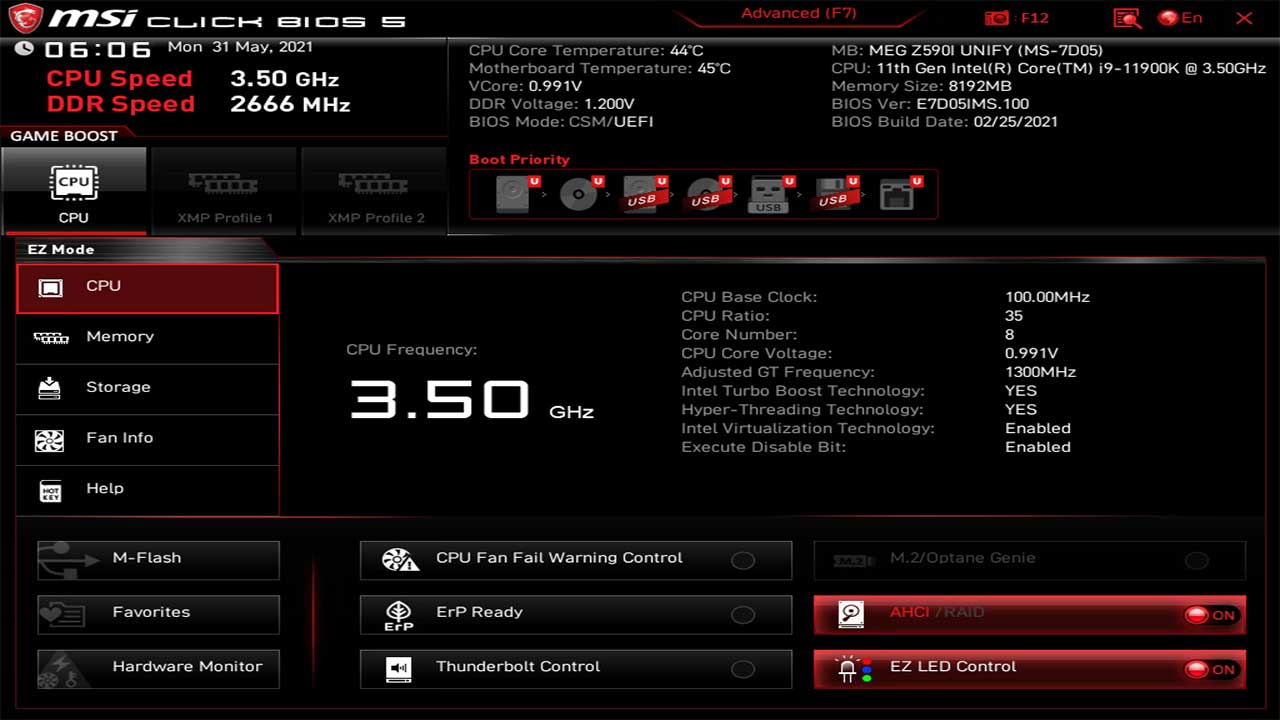
There are 6 main menus under its Advanced Mode with of course the OC menu being the most important one for tuning. Lotsa options here including cooler based optimization. Basically, picking either down-draft, tower or LCS will net different power profiles. I wish this is based on the cooler’s rated TDP.

Hardware monitor shares the same page with the fan profiling which makes absolute sense.
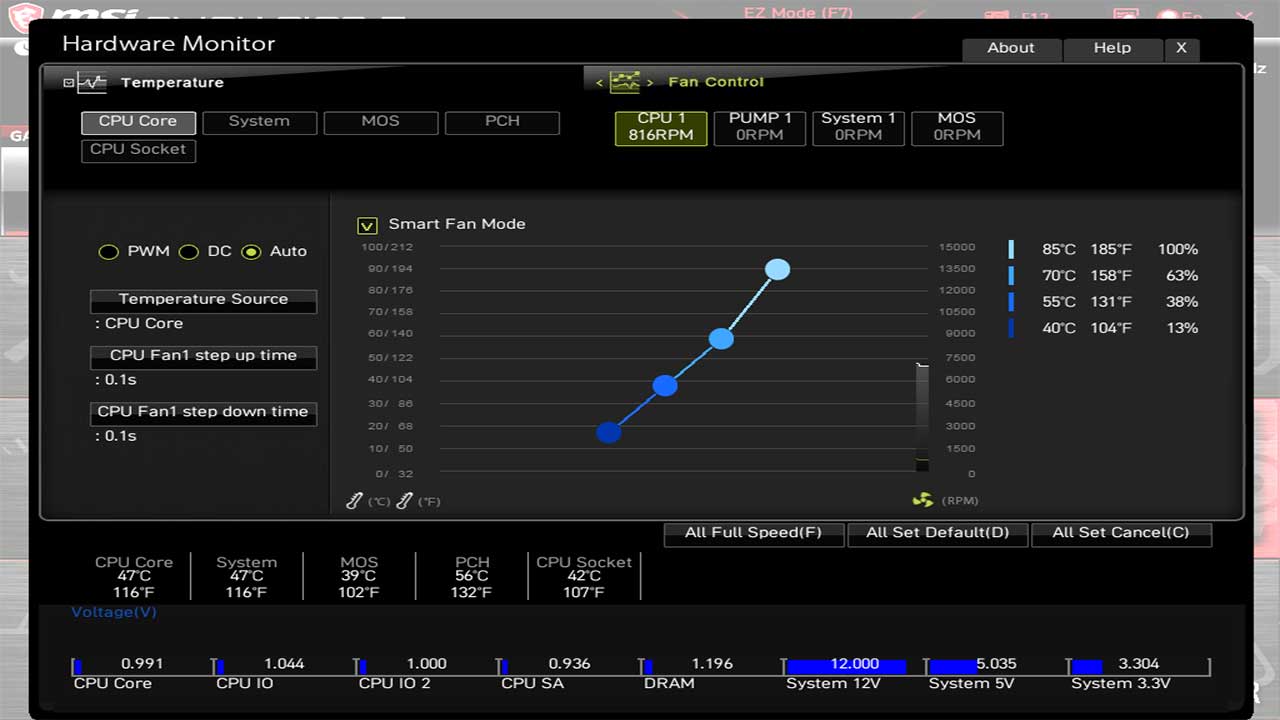
Firmware is good but it’s really getting boring. Hope we’ll see something refreshing for the next MSI motherboard. :)
Test Setup and Methodology
Motherboard performance is evaluated by industry standard benchmark tools and real-world applications – if deemed necessary. It is important to note that we are testing the sample after burn-in, with at least 24-hours of uptime in the case of motherboards. This is done so to negate the physical FOB state performance of the unit, yielding better benchmarking consistency. The device is tested with the following configuration from our test system:
- UEFI configuration: Default
- Windows Power Plan: Balanced
- Windows Game Mode: Disabled
- Windows Game Bar: Disabled
- Windows Security: Disabled
Outlined below is the test system specifications as well as the software used for the review:
| Test System Specifications | |
| CPU | Intel Core i9-11900K |
| Motherboard | MSI MEG Z590I Unify |
| Cooler | Noctua NH-U12S Redux |
| Memory | ADATA Premier 2666MHz 16GB |
| GPU | ASUS Phoenix GTX 1660 SUPER 6GB |
| Storage | Plextor M9Pe PCIe 3.0 NVMe 512GB |
| Case | Mechanical Library JXK-K3 |
| PSU | Thermaltake Toughpower GF1 650W |
| Display | LG UF680T |
| OS | Microsoft Windows 10 Pro 64-bit |
Temperature:
- AIDA64 Extreme Edition – System Stability Test, CPU Sensor
Power:
- AIDA64 Extreme Edition – System Stability Test, Kill A Watt
Noise:
- AIDA64 Extreme Edition – System Stability Test, SPL Meter
CPU, Memory and GPU:
- AIDA64 Extreme Edition – Quick Report, Cache and Memory, GPGPU Benchmark
Storage:
- CrystalDiskMark – Sequential Benchmark
Audio:
- RightMark Audio Analyzer – Test Report
Network:
- NetIO-GUI – Network Transfer Rate
Temperature
We utilized the AIDA64 System Stability Test to check out how the system handles thermals. For this measurement, we loaded the stress test with the CPU as the only option enabled. Temperature readings are taken with HWiNFO with an ambient temperature of 27°C. CPU cooler used for this test is the Noctua NH-U12S Redux.
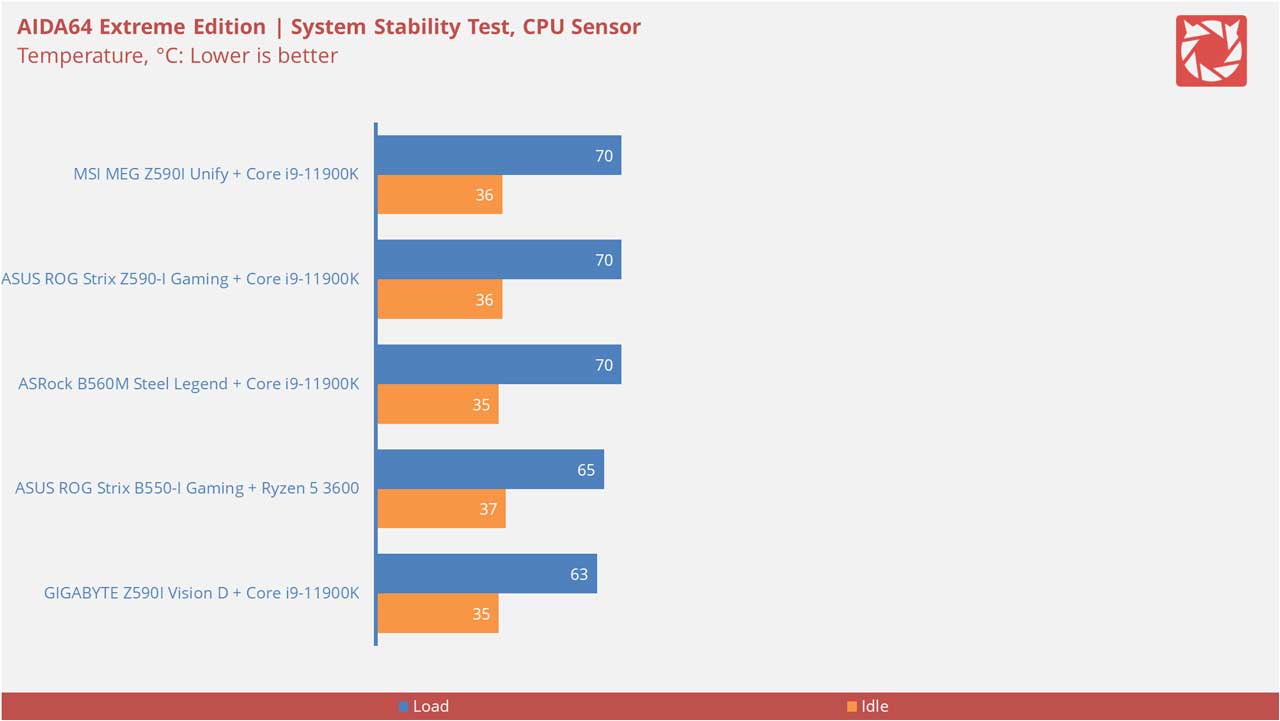
CPU temperature using the tower preset is pretty decent – comparable to other Z590I motherboards with the exception of the GIGABYTE one with a more aggressive fan profile.
Power Consumption
Total system power is also checked out. Power readings are then recorded with a watt-meter while voltage readings for the Vcore and the most common rails are taken via HWiNFO.
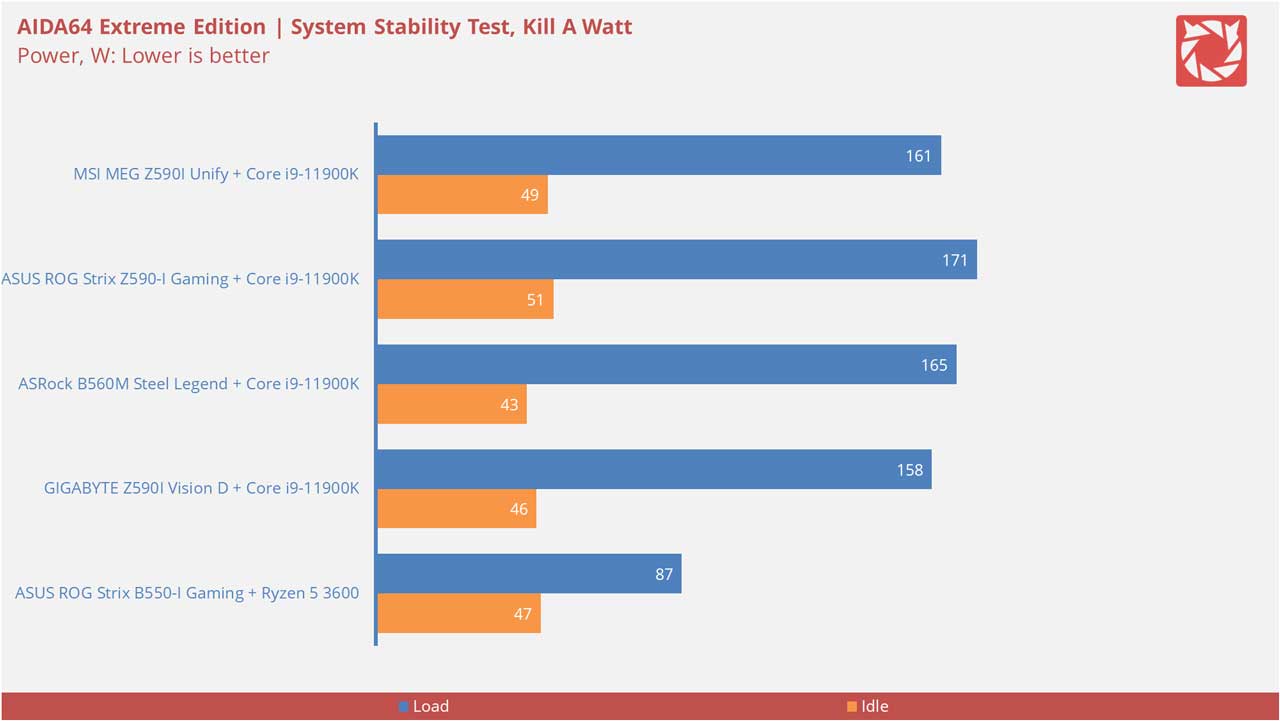
Power consumption is respectable for the little giant.
Noise Level
Noise level is also taken into consideration to check the differences between fan controllers. Decibel readings are taken with an industrial grade A-weighted sound-level meter. Ambient noise floor is ~30dB(A).
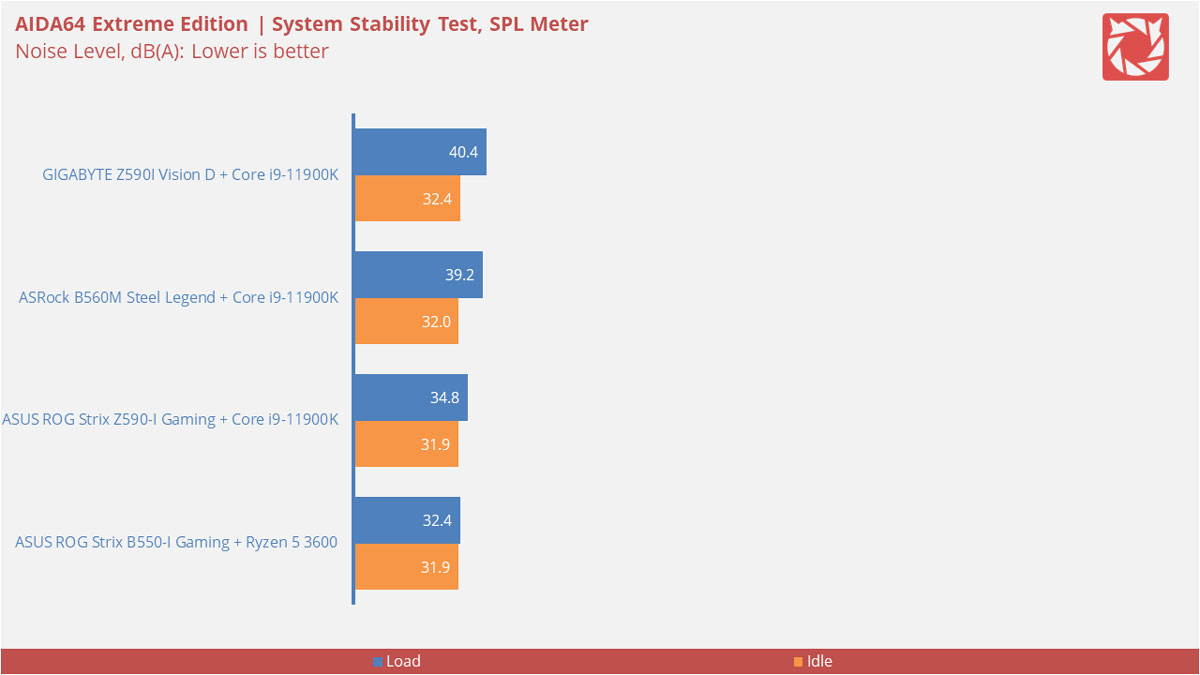
Noise is about where I expected it to be with how it handles thermals. We never even got the chance to get the VRM fan to spin.
CPU, Memory and GPU:
CPU performance is gauged via AIDA64’s CPU Queen Benchmark. This simple integer benchmark focuses on branch prediction capabilities and misprediction penalties of the CPU. Simple, easy to run and replicate.
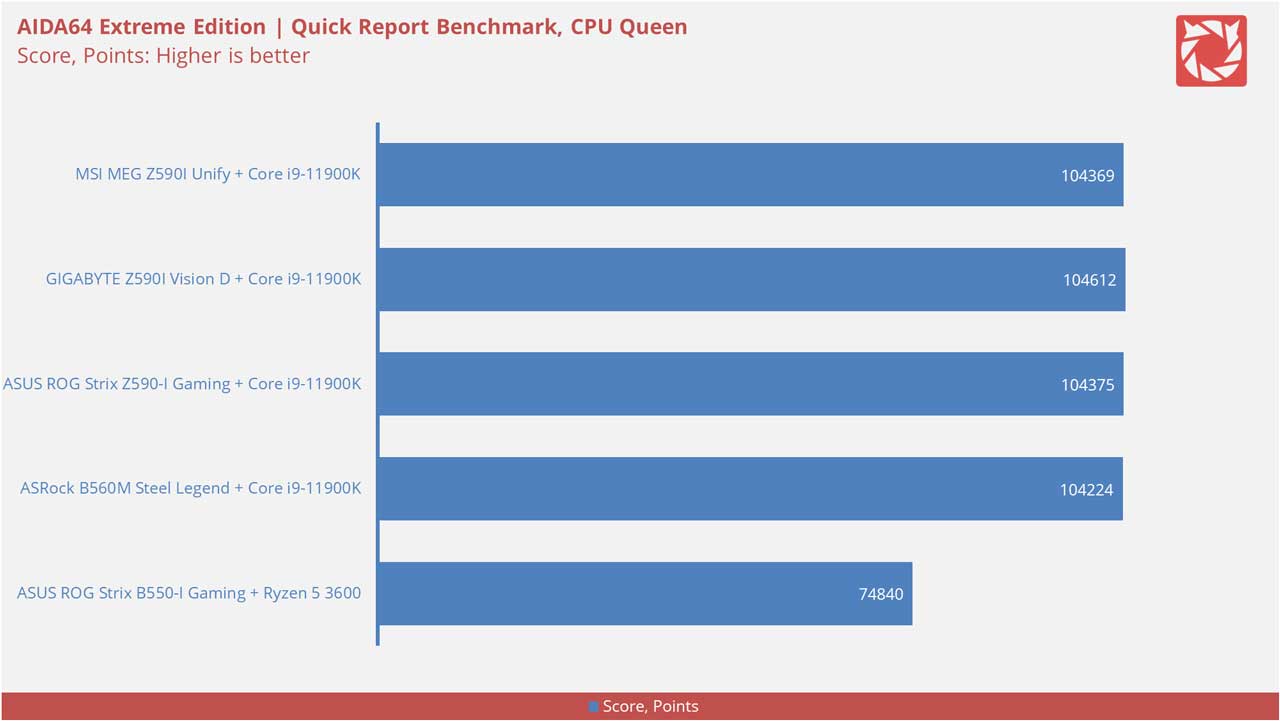
Memory latency is also tested with the Cache and Memory Benchmark built within AIDA64. Latency is what interest us here due to how motherboard designs could affect it.
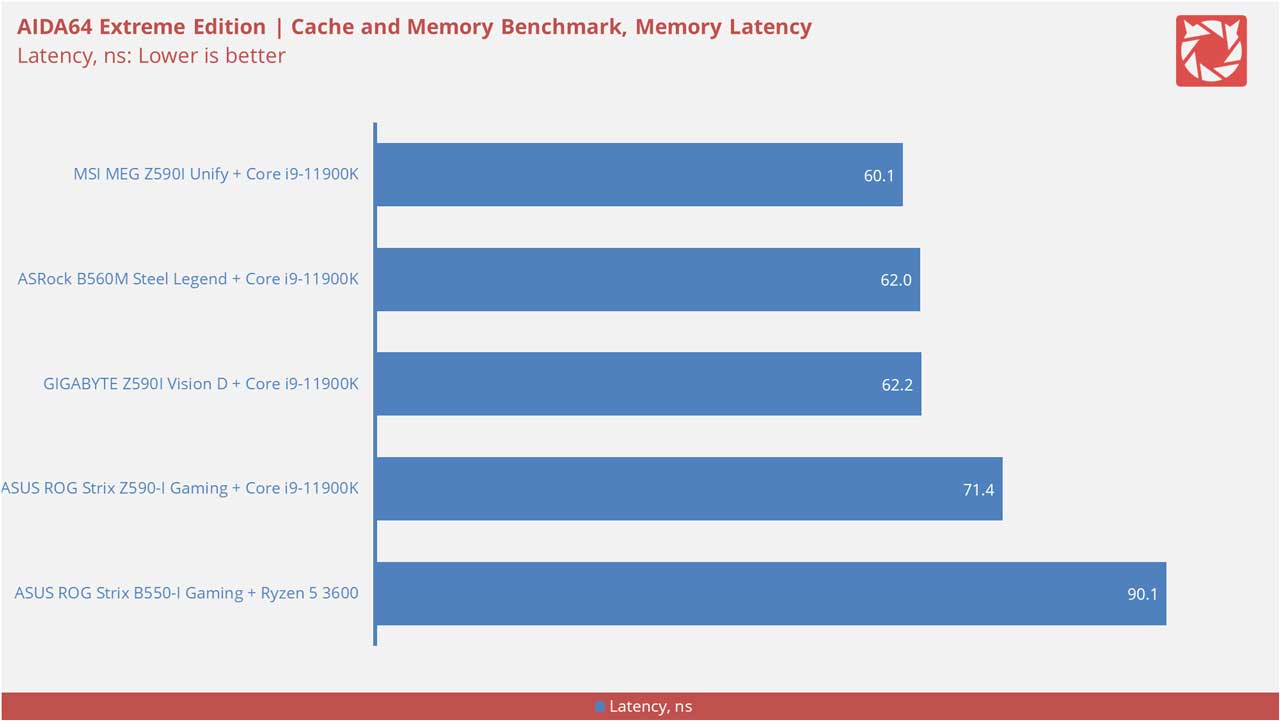
The graphics card and PCIe interface performance are also checked with AIDA64 using the GPGPU Benchmark. We selected the Single-Precision FLOPS benchmark for this test. Results are posted in GFLOPS.
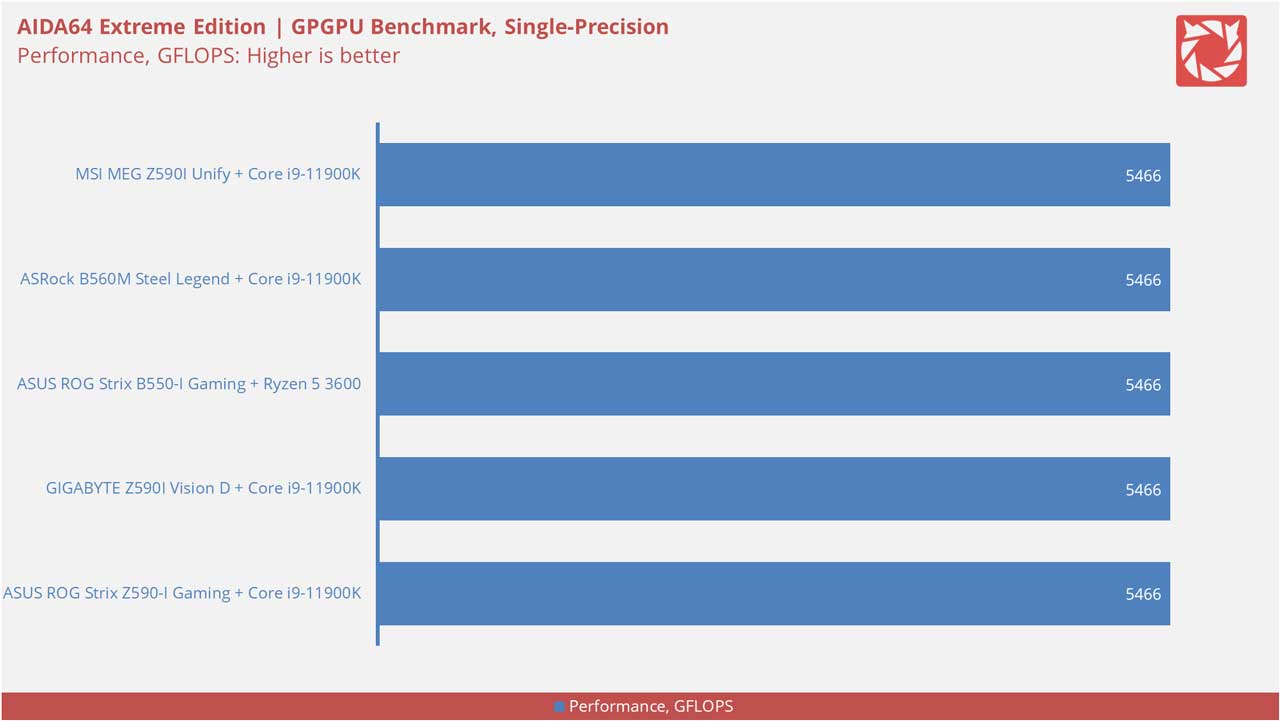
Well there yah go. The MSI MEG Z590I got the best memory latency performance out of the bunch.
Storage Interface
CrystalDiskMark is a simple storage benchmark widely used in the industry. For the storage test, we aim to check out the performance of the most commonly used interfaces found in a motherboard. The sequential read and write are the focus here. Storage devices used are the 256GB (External) and 512GB (Internal) Plextor M9Pe PCIe 3.0 NVMe SSDs.
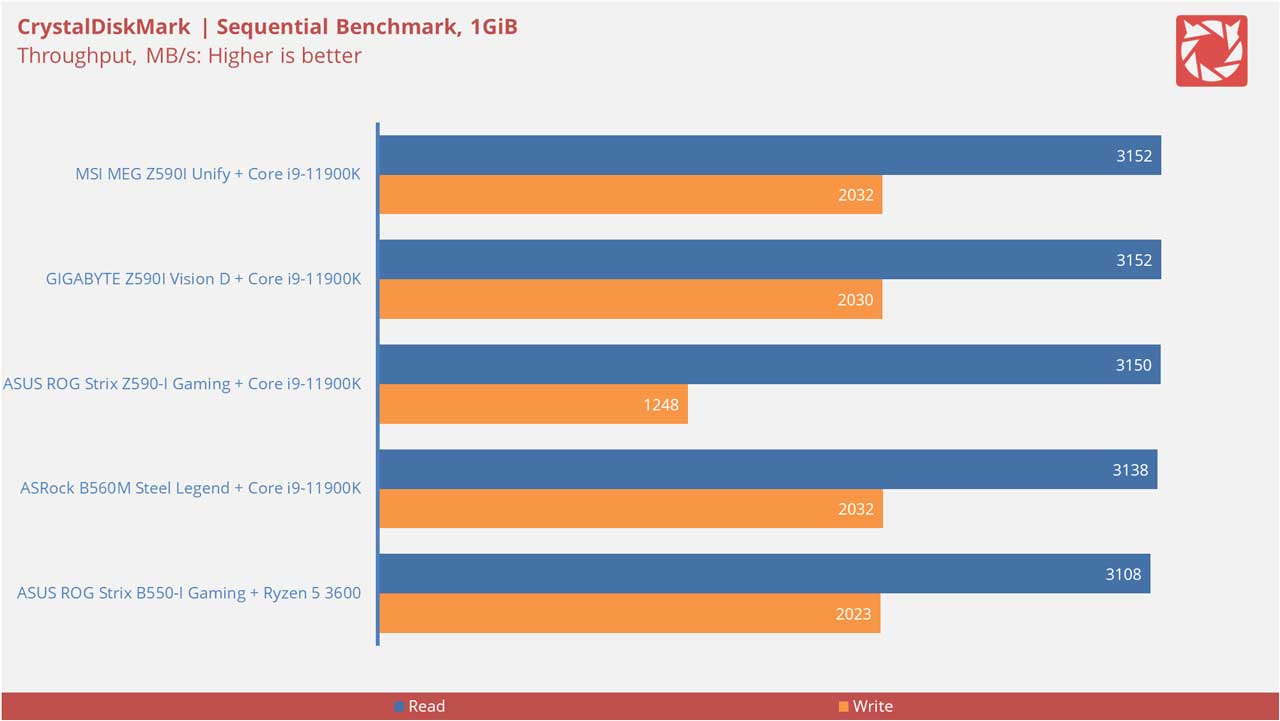
NVMe performance seems within the ordinary. Nothing is out of place here.
Audio Interface
The RightMark Audio Analyzer is a nifty tool to measure the quality of the motherboard’s audio interface. Our results are obtained by playing and recording test tones passed through the audio chain using the Focusrite Scarlett Solo as the ADC. Sampling rate and bit-depth are at 48KHz and 24-bit respectively.
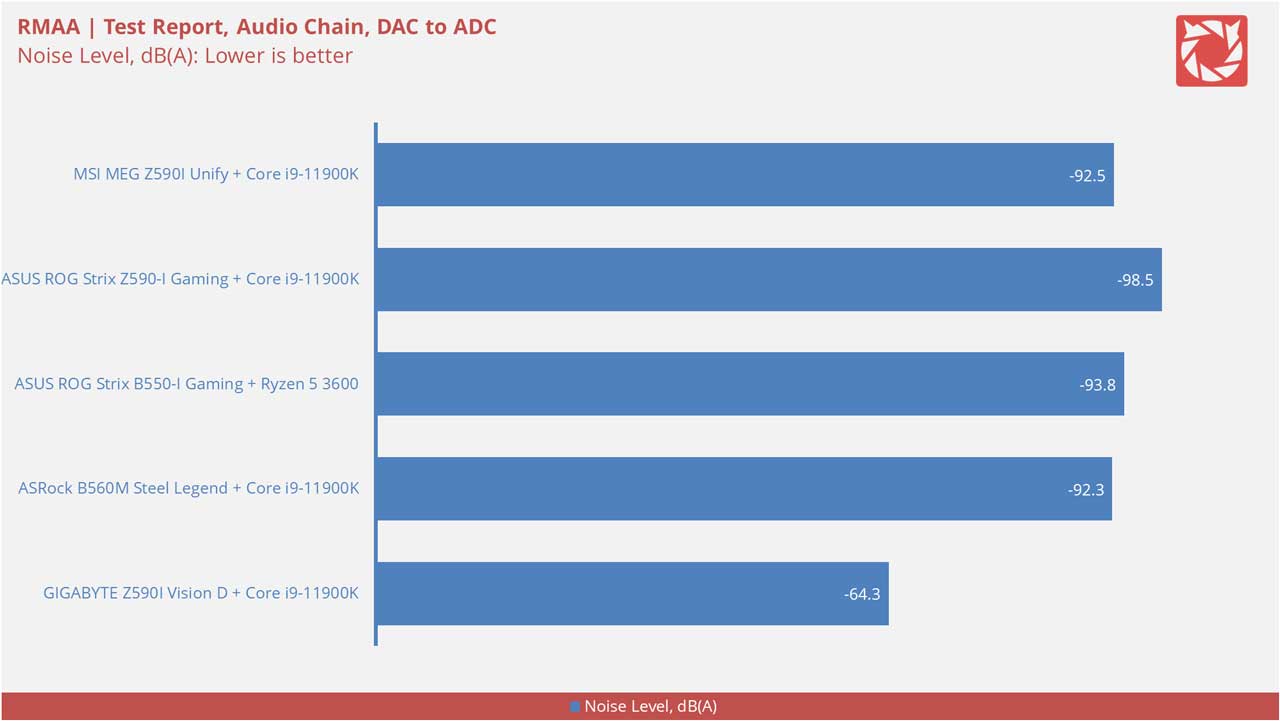
Frequency response should be as flat as possible with acceptable minor deviation across the frequency range of around +/-0.5dB. Test signal for the frequency range contains harmonics from 5Hz to 22KHz.
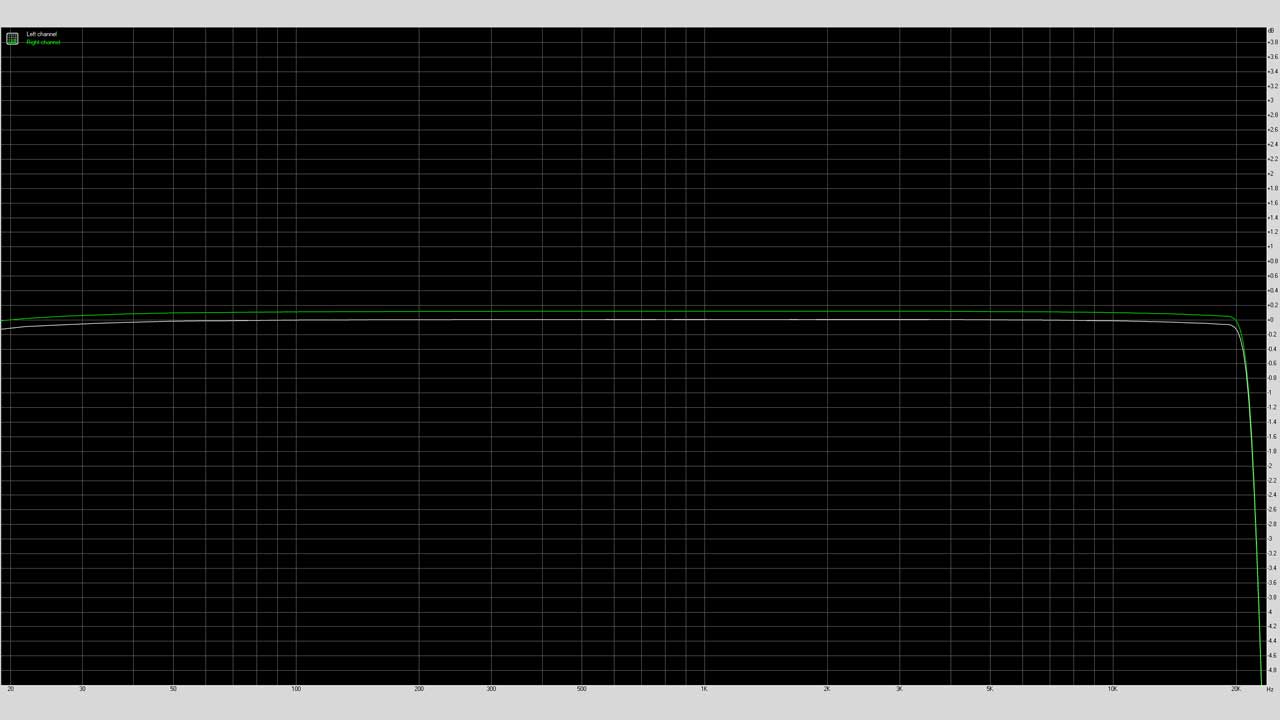
Now THD+N estimates the amount of harmonic distortion that takes place when a signal with large amplitude passes the testing chain. The test signal used here is a sine wave at 1kHz.
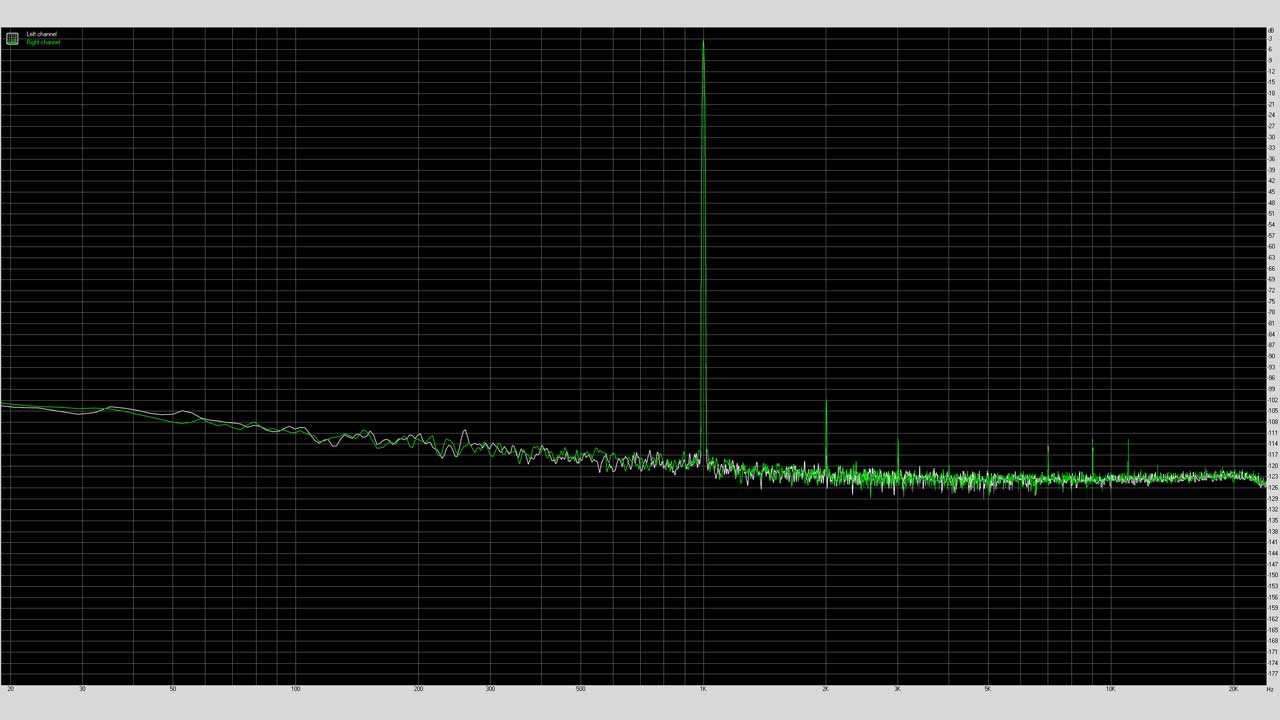
IMD on the other hand estimates amount of intermodulation distortions when a more complex signal passes through a test chain. Measurement uses a two sine wave test signal consisting of low frequency 60Hz tone linearly mixed with a high-frequency 7KHz tone.
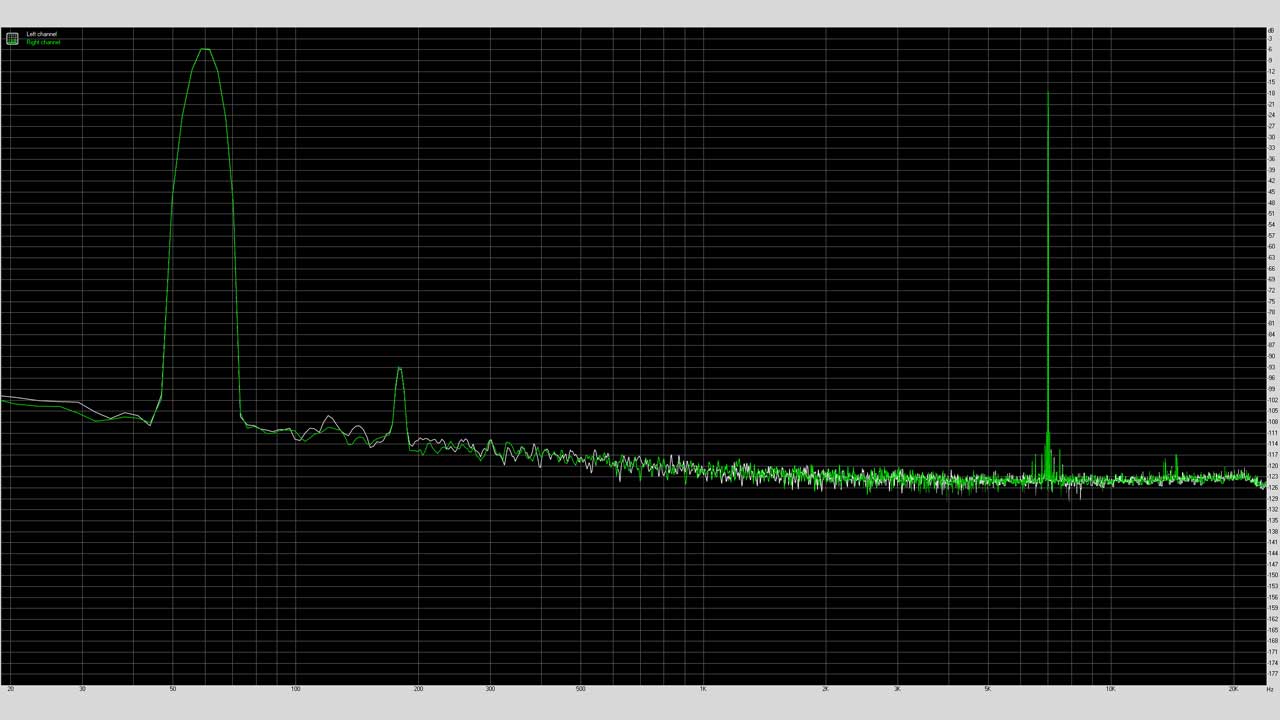
With objectivity in mind, the MSI MEG Z590I Unify’s front panel audio comes with a decent -92.5dB(A) noise level. THD+Noise could be better though at -85.3dB(A) along with a slightly lower stereo crosstalk performance as seen on the not so flat (slight roll at the bass) frequency response.
Now as for the rear panel, it is a cleaner measuring output but not really great for high impedance headphones – since it is really intended for speakers. You may use it to connect to a desktop amplifier though or be happy with it using sub 150Ω offerings – with the exception of current hungry planar-magnetics.
Network Interface
NetIO-GUI is a straight forward Windows frontend application for the “netio” command-line utility. This benchmark requires a client and server for it to work. The ASUS ROG Rapture GT-AC2900 is our router of choice here to test the Ethernet and Wi-Fi performance of our motherboard.
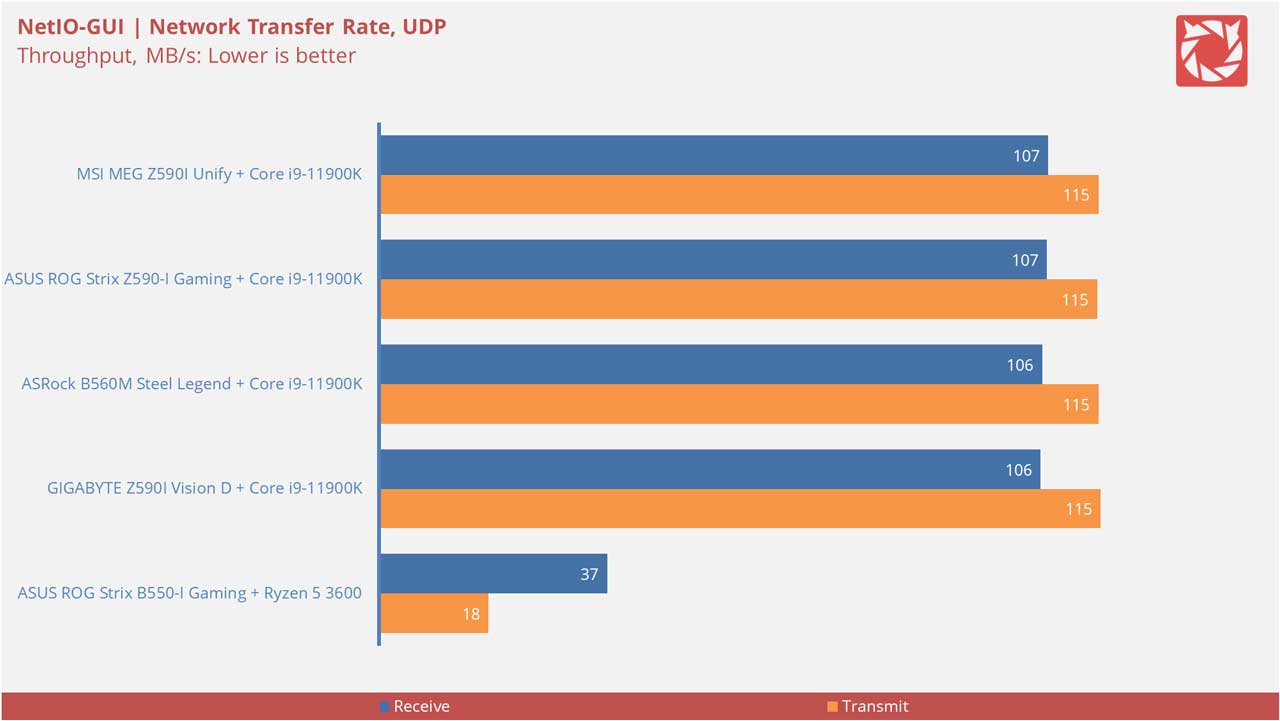
Network performance is pushing my 1GbE setup like the rest. Nothing to complain here really.
Software, Lighting and Special Features
MSI bundled the motherboard with some niceties including a USB stick for easier software and driver installation. Other motherboard vendors should follow suit. We even got double sided brush and a pair of screw drivers.
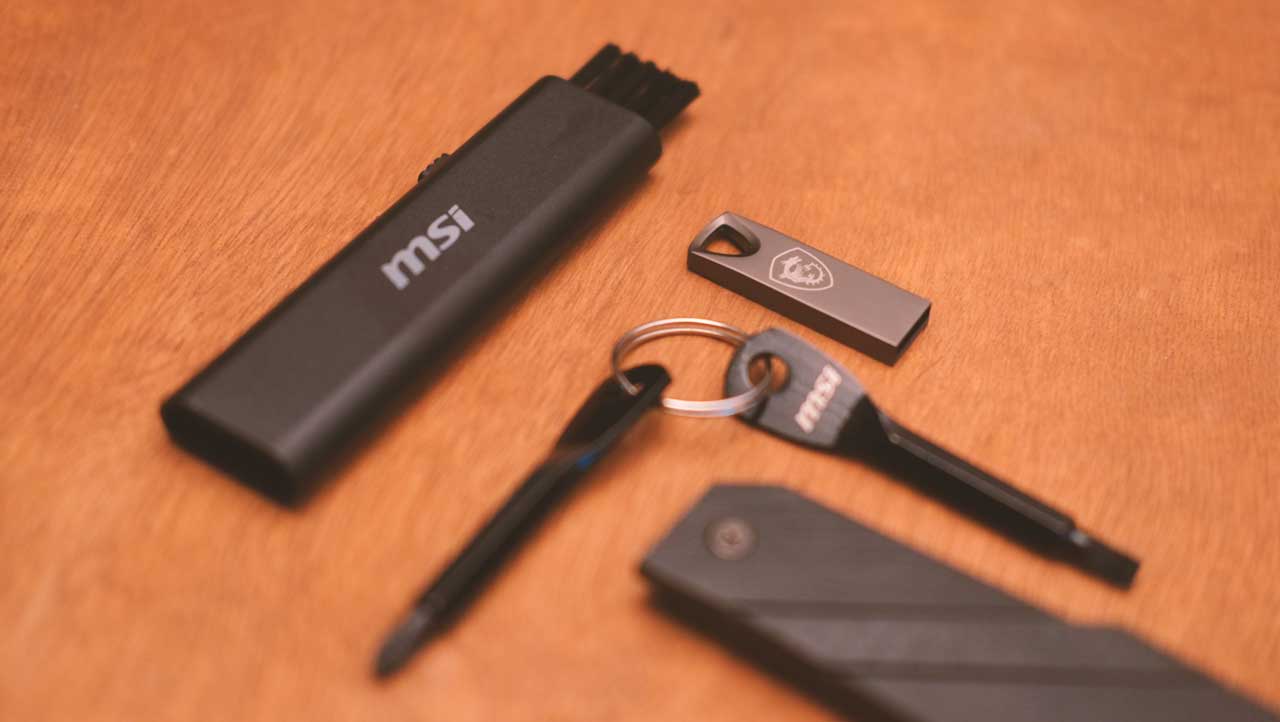
Can’t say anything about RGB lighting since I don’t believe this one comes with any – embedded. We have a 3-pin ARGB header though for good measure.
Final Thoughts
The MSI MEG Z590I Unify is a well measuring SFF motherboard. It is definitely among the best I have tested.
Of course, nothing is perfect and the Z590I Unify is no exception to this rule. The TPM header is located in a tight spot and the front panel audio performance is inferior to that of the rear. We also got a sandwich/double decker style M.2 slot design which is not ideal for higher end SSDs that comes with their own cooling solution.
I may be nitpicking here but those are just the downsides I could find within this board. Everything else is fantastic and with that said, I could happily recommend this Mini-ITX motherboard for those who got the budget to spare.

MSI MEG Z590I Unity
-
Performance - 9/10
9/10
-
Build Quality - 9/10
9/10
-
Connectivity - 9/10
9/10
-
Firmware - 8/10
8/10
-
Features - 9/10
9/10
Summary
The MSI MEG Z590I Unify is one well-balanced high-end motherboard. It comes with everything you’d expect from a flagship model with a few extras here and there for good measure. A few hiccups could be seen but it wont stop me from recommending this one though. It’s that good.
Pros
- Excellent well-balanced overall performance
- Crazy amount of aluminum – quality build!
- Tons of connectivity options – Thunderbolt 4 is a huge plus
- Excellent bundle of accessories
- Good rear panel audio with DSD support – but not for high impedance headphones
Cons
- TPM header under the PCIe latch
- Front panel audio performance
- Dated UEFI design
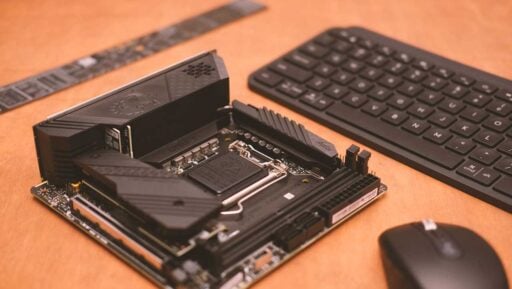
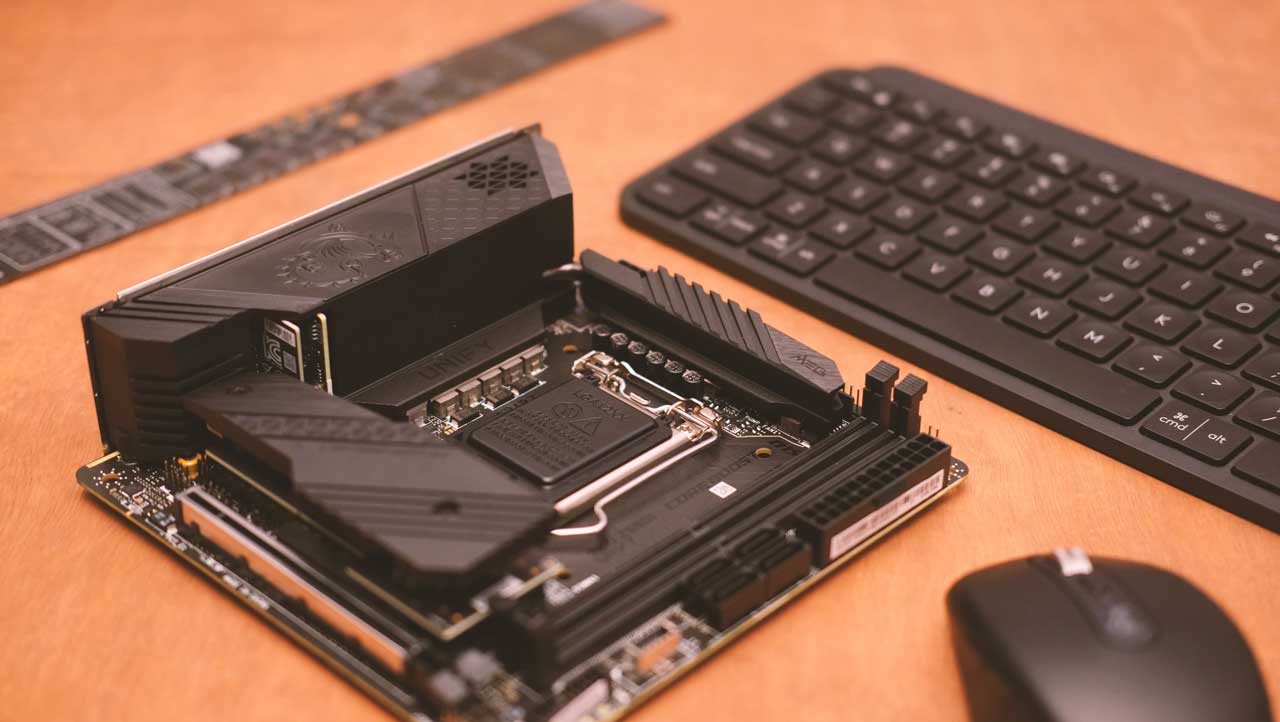
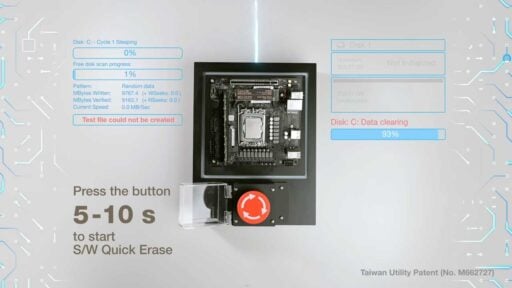


The comparative graph for noise level doesn’t show the MSI board.
Good review!
Hi, please refresh it. Displays on my end just fine. :)
Hi Leo. Thanks for your comprehensive review. I’m wondering could you please do some additional test on the M.2 thermals? I now have a MSI Z490I Unify at hand but both M.2 drives (one 980 Pro 2TB, one 970 evo plus 1TB) are getting pretty hot even at idle (around 60C), which kind of worries me though I do have the data back-up. I would like to know if there’s improvement on this Z590I board. Thanks.
Hello! Unfortunately, I cannot do that – as the unit has been returned already to the manufacturer. That said, I will consider M.2 thermals in the future!
Now usually on sandwiched M.2 bays, the best you could do is put the hottest and most active drive at the top. That way, you could also use third party cooling solutions. By design, ITX motherboards with sandwiched M.2 slots are just really limited.
Hi Leo, thanks for your reply. I’m currently not sure what caused the m.2 drives to heat this much on my MSI Z490I board but I’ve been using ITX board for years and didn’t record any similar temps in any other boards but this one. So I guess there could be some design flaws because a quick search on the Internet and you could find many complaining about the MSI M.2 “heat shield” ended up increasing the drive temp. So I’m quite curious if MSI solved this on Z590I. Also, I have to note Z490I does have a heatpipe connecting the PCH area and the power delivery unit, which might have conducted the heat from power delivery unit to the PCH (and M.2). And there’s a 4cm fan there but it didn’t seem to improve the thermals much because it blows directly onto the heatpipe without any heatsink.
Anyway, thanks and hope you could look more carefully into the m.2 thermals in the future ITX review.